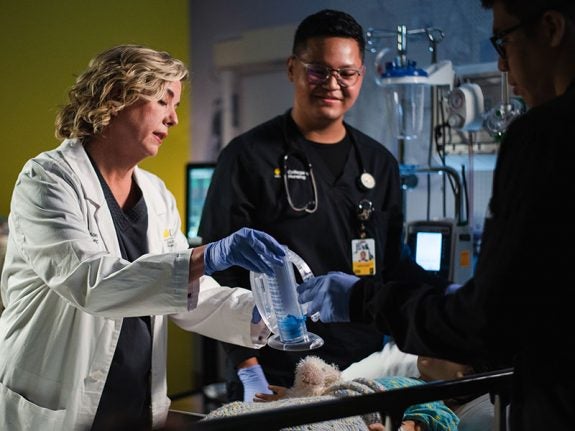Healthcare Industry Trends to Watch For in 2019

Mobile Health
One emerging trend is the use of mobile health (mHealth), the use of smart devices, patient monitoring applications or other mobile technologies that are used in healthcare settings to the benefit of patient health, as noted in a Healthcare Financial Management Association article.
A Healthcare Information and Management Systems Society survey found that more than 50 percent of surveyed respondents worked at hospitals using three or more mHealth technologies. Specifically, a few of the areas where mHealth were particularly beneficial were: “mobile optimized patient portals,” telehealth, texting, remote monitoring, education apps and “patient-generated health data,” according to the survey.
- A PricewaterhouseCoopers report further notes that mHealth may more broadly impact the following trends in healthcare: aging populations, the “foundations of industrialization of healthcare” and personalization services. With aging populations, mHealth can improve access to and quality of care as well as lower costs for aging populations.
- mHealth is quickly being adopted by healthcare facilities because it uses preexisting electronic materials such as electronic health records, using a preexisting foundation to build upon.
- mHealth can also offer personalized tools, such as blood pressure monitoring and daily health analysis, for preventive, participatory and predictive care.
Patient-Centric Health Systems
Another emerging trend is the shift toward putting the patient at the center of health systems. As a Fortune article reports, health care provider Kaiser Permanente has been making that exact shift. With more than 12 million members, KP not only works with traditional hospital networks but also allows its members to connect with their physicians conveniently by email and video chat. Such patient-centric health systems, especially those with telehealth integration, may be an important driver in the healthcare industry in the near future.
Consumer-Directed Health Plans
Another healthcare industry trend involves consumer-directed health plans or CDHPs, which employees use for medical expenses. As noted by the Society for Human Resource Management, CDHPs merge the benefits from “a high-deductible health insurance plan with a tax-advantaged account.” According to the Large Employers’ Healthcare Strategy and Plan Design Survey from the National Business Group on Health (NBGH), this year 9 percent fewer employers will offer just CDHPs. This is important, “reflecting a move by employers to add more choice back into the mix” with options, such as preferred-provider organizations, according to Brian Marcotte, the president and CEO of NBGH.
Nontraditional Healthcare Players
Many nontraditional players, especially those from technological fields, are entering the healthcare industry. As Dr. Gregory Welch, Florida Hospital Endowed Chair in Healthcare Simulation at the University of Central Florida’s College of Nursing, puts it, “The expansion of healthcare to include non-traditional players for services and technology is very exciting in that the trend has encouraged the move from episodic examinations (once or twice per year) to continuous monitoring of our health and behavior. As the integration of health applicable technologies – such as mHealth and telehealth – become more present in healthcare operations, tech companies looking to stay ahead of the pack are keeping an eye on upcoming healthcare opportunities.”
Amazon.com
In 2018, Amazon, JPMorgan Chase and Berkshire Hathaway partnered to form a healthcare venture. Amazon also has wholesale pharmaceutical distribution licenses in several states and is expected to start its own medical supply company. The company’s entry into the healthcare industry is part of a growing healthcare trend, wherein tech companies are stepping into healthcare spaces to offer entirely new ways of delivering healthcare to employees.
Apple
Healthcare industry trends are also pointing to other nontraditional healthcare players, such as Apple, Alibaba, Samsung, and Tencent. Apple has recognized the importance of the healthcare market, which makes up a tenth of the $70 trillion global GDP. Tim Cook, Apple’s CEO, said “the healthcare market makes the smartphone market look small,” as reported by CB Insights. So far, Apple has already released the Health Records app and the Apple Watch, both featuring health services such as heart rate monitoring and daily activity tracking. With Apple products universally well known, any applications for healthcare for an Apple device would likely have a large impact on the healthcare industry.
Virtual Assistants
According to a HealthITAnalytics.com report, virtual assistants have already become important time- and energy-saving tools for some healthcare fields. Assistants such as Alexa, Siri and Cortana can complete administrative tasks and also help answer customers’ questions.
“What’s exciting is that I think if you went back 10 years and asked people about their willingness to subject themselves to continuous monitoring, for example, they would have responded negatively. And yet you see such monitoring being slowly introduced into watches and phones, for example and I don’t hear people complaining—indeed there are stories of such a device alerting the wearer to heart abnormalities,” says Welch. It helps that companies are focused on privacy and security, and that people have to opt-in to participate. People are becoming more receptive to private awareness of data from continuous monitoring. Consider your feelings toward it the next time your watch encourages you to go on a walk, or your phone alerts you to drink water.
Dehospitalization
Hospitals have been a mainstay of the healthcare industry for a long time. Now, due to technology, trends in healthcare are moving away from the idea that hospitals are the only place to receive care or provide other resources, such as outpatient or aged-care facilities. When patients move away from hospital-based care to external resources that can be found outside of larger facilities, the process is known as dehospitalization. As more resources become available, patients are able to choose the course of care that suits their bodies and situations in the best way possible, whether it is in a hospital or dehospitalized to an outpatient or aged-care facility.
Natural Language Processing
Recently, the inrush of big data in the healthcare industry has been paving the way for natural language processing to help improve delivery of care. Algorithms have been shown to have vast application potential, particularly in simplifying healthcare documentation and enabling voice-to-text dictation. As information technology progresses, the integration of natural language processing into healthcare settings is expected to further increase. MarketsandMarkets, a research firm, projects the natural language processing market will more than double in size from 2016 to 2021—reaching about $16 billion in market opportunity. This sharp increase is important because it indicates a coming healthcare trend of using the technologies to elevate patient care.
Whether a recent graduate entering the healthcare industry or an established professional, staying current on trends is a must. Trends such as mHealth, natural language processing, and dehospitalization have potentially huge roles to play in the healthcare industry for the future. When professionals gain a better understanding of these impending shifts, they have the potential to expand not only their own knowledge of current trends, but also the quality of treatment provided to those in their care.
UCF’s Online Healthcare Degrees
- Autism Spectrum Disorders
- Chemistry, MS - Forensic Science
- Executive Master of Health Administration, EMHA
- Fundraising
- Gender Studies
- Health Informatics, BS
- Health Information Management, BS
- Health Services Administration, BS
- Healthcare Simulation
- Healthcare Systems Engineering Certificate
- Healthcare Systems Engineering, MS
- Integrative General Studies, BGS
- Interdisciplinary Studies, BA/BS
- Master of Public Administration, MPA
- Master of Science in Healthcare Informatics
- Master of Social Work Online
- Nonprofit Management
- Nonprofit Management, MNM
- Nursing Education
- Nursing Practice, DNP, Advanced Track
- Nursing Practice, DNP, Executive Track
- Nursing, BS
- Nursing, BSN to PhD
- Nursing, MSN
- Nursing, PhD
- Project Engineering
- Psychology, BS
- Public Management and Leadership
- Research Administration Certificate
- Research Administration, MRA
- Systems Engineering







